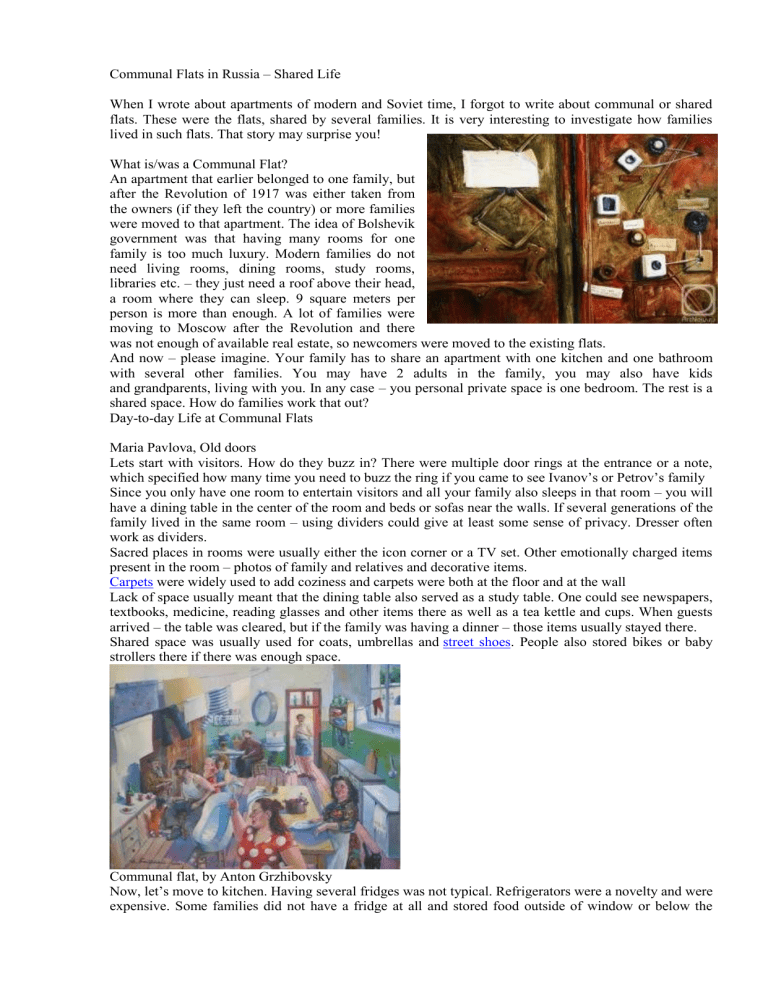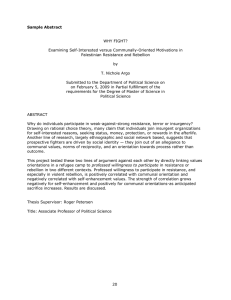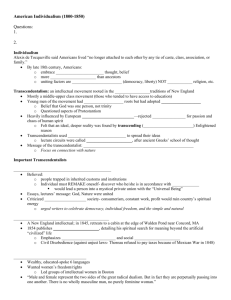
Communal Flats in Russia – Shared Life When I wrote about apartments of modern and Soviet time, I forgot to write about communal or shared flats. These were the flats, shared by several families. It is very interesting to investigate how families lived in such flats. That story may surprise you! What is/was a Communal Flat? An apartment that earlier belonged to one family, but after the Revolution of 1917 was either taken from the owners (if they left the country) or more families were moved to that apartment. The idea of Bolshevik government was that having many rooms for one family is too much luxury. Modern families do not need living rooms, dining rooms, study rooms, libraries etc. – they just need a roof above their head, a room where they can sleep. 9 square meters per person is more than enough. A lot of families were moving to Moscow after the Revolution and there was not enough of available real estate, so newcomers were moved to the existing flats. And now – please imagine. Your family has to share an apartment with one kitchen and one bathroom with several other families. You may have 2 adults in the family, you may also have kids and grandparents, living with you. In any case – you personal private space is one bedroom. The rest is a shared space. How do families work that out? Day-to-day Life at Communal Flats Maria Pavlova, Old doors Lets start with visitors. How do they buzz in? There were multiple door rings at the entrance or a note, which specified how many time you need to buzz the ring if you came to see Ivanov’s or Petrov’s family Since you only have one room to entertain visitors and all your family also sleeps in that room – you will have a dining table in the center of the room and beds or sofas near the walls. If several generations of the family lived in the same room – using dividers could give at least some sense of privacy. Dresser often work as dividers. Sacred places in rooms were usually either the icon corner or a TV set. Other emotionally charged items present in the room – photos of family and relatives and decorative items. Carpets were widely used to add coziness and carpets were both at the floor and at the wall Lack of space usually meant that the dining table also served as a study table. One could see newspapers, textbooks, medicine, reading glasses and other items there as well as a tea kettle and cups. When guests arrived – the table was cleared, but if the family was having a dinner – those items usually stayed there. Shared space was usually used for coats, umbrellas and street shoes. People also stored bikes or baby strollers there if there was enough space. Communal flat, by Anton Grzhibovsky Now, let’s move to kitchen. Having several fridges was not typical. Refrigerators were a novelty and were expensive. Some families did not have a fridge at all and stored food outside of window or below the window sill in winter. “Wealthy people” had their own fridge in their bedroom. If the fridge was in the kitchen and was shared – it would be a dorm-like setup – you have your own shelf or leave notes, attached to your food Now, the bathroom. In large families morning time logistics is hard enough. Imagine you have a several families, who share the bathroom?! If the relationship is decent, people work out a bathroom schedule and adhere to it, if not – it is an issue. But some people like to take long baths or showers and in addition to the inconvenience, they may spend more water or electricity. That was also an issue to discuss. Will go call, by Dmitry Annenkov Most often – you just had one landline and the phone was in the shared space – a lobby or a corridor. Your neighbors would always call you if they answered the call. But they will notice, who called you and will overhear your conversation. And will not be happy if you talk for too long when they are expecting an important call Implications Of Living in a Communal Flat In general communal living required a lot of skills: Cooperation The best apartments were the ones where inhabitants managed to agree on day-to-day things, such as when to use the bathroom, when to cook and what are the other rules of the house. Following the rules of the house was key, whatever the rules were. For example in some apartments washing clothes was to be done in the bathroom, in some apartments – in the separate zone in the kitchen. Having social rules, such as who and when could visit, how loud the visitors could be etc. also made a lot of sense. Negotiation skills Rules are to be discussed. Usually in communal flats there was a set of rules, which was developed for years if not decades. But things changed with new neighbors or new circumstances. Re-negotiating the rules was important Conflict management Conflicts happen even in families, among people, who love each other, among relatives. Living in a shared space with strangers of course leads to conflicts. And if not managed properly – conflicts do escalate. Most typical stories include spitting in soup in a communal kitchen. To make sure that does not happen – people tried to be nice to each other. For example – if a neighbor asks you, what you are cooking – invite her to try the dish or do a small favor (such as lending some milk or flour or other staple food that she forgot to buy that day). Small favors go long way. Communal flat phone, not sure about the name of the artist Privacy management As you imagine – there is not much privacy in a communal flat. Your neighbors actually have too much information about you – they know when you leave to work, when you return, they overhear your phone conversations since the phone is in a lobby, they see all your visitors, they judge your habits (especially if you have any bad habits), they see how you dress and they even know which soap you use and how your underwear looks like (literally, since you hang it out for drying in the bathroom). So, even if you do not talk too much about your life, they see your life. Usually the way to manage privacy was to maintain privacy in your room and to limit conversations with neighbors to “need to know” Influence Of Communal Living On Russian Mentality I am sure that there were professional studies on that subject. I will try to find them and update this post. And for now – here are some of my guesses: Communal flat corridor, http://fishki.net/1243310-kommunalnaja-kvartira.html?mode=tag:kommunalka Personal Space I always notice that Russian people stand too close to me, when we talk. I do not mind that with close friends, but do not feel comfortable when strangers come so close or stand in line right next to me (I spent most of my childhood abroad, that is why I have different borders of personal space). I think that the communal living may be one of the reasons. You get used to share your personal space with other people day-to-day, so it shrinks Standing in lines Thankfully the only place where one still has to stand in line in Moscow is the Russian Post Office. But in Soviet times people had to stand in lines daily, when they were buying groceries, clothes or anything else. Figuring out a way to manage lines “fairly” was quite like figuring out the schedule of using a bathroom in a communal flat. People, who lived in communal flats, were trained to wait for a lot of things Communication/Cooperation If you can live for decades with strangers in the same home, you become really good in communication. You know how to trade favors, you know how to negotiate, how to keep up relationships. That is definitely a good thing about communal living Being judgemental I already wrote that it is typical for Russia. “I know better what is good for you and I will tell you about that right now” is a very typical Russian behavior. I am not sure whether the roots come from the communal living or it is just our personality trait. But it might be a consequence of communal living. You see the life of several other families as an insider, on a daily basis. You see the mistakes they make and privacy boundaries blur with time. You tell your neighbor what you think first (in a direct, “Russian way”) Next time you find yourself telling a stranger on the street, how she should dress her kids! My Personal Experience Сommunal kitchen interior, Museum of a Political History of Russia I never lived in a communal flat myself, but when my parents were young – they lived in such flat in the very center of Moscow. My mom has mixed feelings about that time – on the one hand they were young and happily married, on the other hand – they had a neighbor, who had dozens of cats in her room and liked to collect garbage on streets. When my parents managed to buy their own flat, which was located further from the center – they were so happy to move out of the communal flat! It was a 3 room flat and they had furniture just for one room. So, my mom was moving furniture back and forth until they got enough furniture to fill that apartment. I find these stories super interesting as they are the stories of the life I never experienced myself! My grand-aunt lived in a communal flat, also steps from Kremlin and I have been to this flat many times. There were 3 bedrooms, a shared kitchen and a shared bathroom. People, who lived in that apartment knew each other for decades and they had good relationship balance, so it was quite peaceful. But the landline phone was in the lobby, so overheard conversations were always commented upon. For example I remember that her neighbors had a teenage boy and some girl regularly called him and my grand-aunt disapproved of that (“a girl should never call a boy!”) How Did People Get Their Own Apartments in Soviet Time? There were several ways: “Pyatietazhka” – 5-storey residential building – typical for the 60s-70s The most straightforward was to wait when the State will give you a new apartment. In Soviet time, the minimum norm was 9 square meters per person. If a family of several people were living in one room in a communal flat – they were eligible for improving their living conditions. Getting a separate flat involved red tape and a long wait lists, but eventually a lot of people got new apartments free of charge. If you did not want to wait – you could do the following: do something important – become a well-known singer, writer, artist etc. Soviet Union recognized that and could give you an apartment for your talent be very active in Communist party, lead people and get an apartment via your contribution to the Party sign up for cooperative condo house if you have money (that is what my parents did, they took a loan from the relatives for that) exchange two or three rooms in communal flats for one apartment. That required a lot of business skills, but was doable After the Perestroika (the 90-s) you could just buy an apartment if you had enough money or could negotiate with multiple families and try to better living conditions for your family, but also for other families, if they agree to move further from the center There are still people living in communal flats in Russia, although that is rather an exception now I wonder which other countries had a practice of communal housing. I assume that should be countries of former Eastern European block, but maybe this practice existed (or still exists) elsewhere? Please share your experiences with me! And if you happen to have photos of communal flats – I and the readers of my blog would be thrilled to see them!


